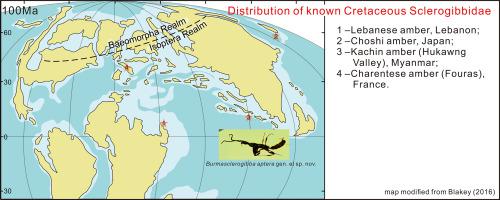当前位置:
X-MOL 学术
›
Gondwana Res.
›
论文详情
Our official English website, www.x-mol.net, welcomes your feedback! (Note: you will need to create a separate account there.)
A golden age for ectoparasitoids of Embiodea: Cretaceous Sclerogibbidae (Hymenoptera, Chrysidoidea) from Kachin (Myanmar), Charentes (France) and Choshi (Japan) ambers
Gondwana Research ( IF 6.1 ) Pub Date : 2020-11-01 , DOI: 10.1016/j.gr.2020.06.004 Evgeny E. Perkovsky , Kateryna V. Martynova , Toshiharu Mita , Massimo Olmi , Yan Zheng , Patrick Müller , Qi Zhang , Flavie Gantier , Vincent Perrichot
Gondwana Research ( IF 6.1 ) Pub Date : 2020-11-01 , DOI: 10.1016/j.gr.2020.06.004 Evgeny E. Perkovsky , Kateryna V. Martynova , Toshiharu Mita , Massimo Olmi , Yan Zheng , Patrick Müller , Qi Zhang , Flavie Gantier , Vincent Perrichot

|
Abstract Sclerogibbid wasps are obligate parasitoids of webspinners (Embiodea). Both groups have a particularly scarce geological record and are known since the Cretaceous: there are only four species of webspinners known from Burmese amber, and only two sclerogibbids were described from Barremian Lebanese and Cenomanian Burmese ambers. Here we report transferred genus from Aptian Choshi (Japan) amber and new sclerogibbids from Cenomanian Burmese and Charentese (France) ambers. The taxa described from Burmese amber are: Burmasclerogibba aptera gen. et sp. nov., Cretosclerogibba gen. nov. (with C. antennalis sp. nov., C. contractocollis sp. nov., C. neli sp. nov. and C. rasnitsyni sp. nov.) and Edrossia vetusta gen. et sp. nov. The first European fossil sclerogibbid Gallosclerogibba alnensis gen. et sp. nov. is described from Charentese amber. The holotype of Chosia yamadai Fujiyama, from Choshi amber, is re-described; it appears to be the oldest Laurasian sclerogibbid. The significant abundance and variety of Burmese sclerogibbid wasps (60% of fossil species known worldwide), as proxy of their hosts, were probably caused by the protection granted to them by the silk webs and possibly by the limited predation from ornithuromorph birds or crown-group ants. While all three extant sclerogibbid genera have apterous females, genera with winged females (Cretosclerogibba and Edrossia) dominated in Burmese amber. Small silk galleries from hosts may have favored the preservation of wings in females of Cretaceous sclerogibbids. Most new species described in the present paper, in addition to C. yamadai, are characterized by a very slender neck and a very long frontal process concealing the antennal toruli. These characters disappeared in extant species. We suggest that this loss was caused by a change in the fauna of predators, penalizing species with long neck and rostrum.
中文翻译:

Embiodea 外寄生物的黄金时代:来自克钦(缅甸)、夏朗德(法国)和铫子(日本)琥珀的白垩纪 Sclerogibbidae(膜翅目、Chrysidoidea)
摘要 Sclerogibbid 黄蜂是蜘蛛纲(Embiodea) 的专性寄生蜂。这两个群体的地质记录都特别稀少,并且自白垩纪以来就已为人所知:从缅甸琥珀中发现的蛛网蛛只有四种,而在巴雷米安黎巴嫩和塞诺曼尼亚缅甸琥珀中只发现了两种硬壁蛛。在这里,我们报告了来自 Aptian Choshi(日本)琥珀的转移属以及来自 Cenomanian 缅甸和 Charentese(法国)琥珀的新 sclerogibbids。从缅甸琥珀中描述的分类群是:Burmasclerogibba aptera gen。等 sp. 十一月,Cretosclerogibba gen。十一月 (与 C. 触角 sp. nov.、C. contractocollis sp. nov.、C. neli sp. nov. 和 C. rasnitsyni sp. nov.)和 Edrossia vetusta gen。等 sp. 十一月 第一个欧洲化石 sclerogibbid Gallosclerogibba alnensis gen。等 sp. 十一月 是从夏朗德琥珀中描述的。重新描述了来自铫子琥珀的 Chosia yamadai Fujiyama 的正模标本;它似乎是最古老的Laurasian sclerogibbid。缅甸硬齿蜂(全世界已知化石物种的 60%)的显着丰度和多样性,作为其宿主的代表,可能是由于丝网给予它们的保护,也可能是由于鸟形鸟类或冠冕的有限捕食群蚂蚁。虽然所有三个现存的 sclerogibbid 属都有无翅雌性,但在缅甸琥珀中,有翅雌性的属(Cretosclerogibba 和 Edrossia)占主导地位。来自寄主的小型丝绸画廊可能有利于保存白垩纪硬壁类雌性的翅膀。本论文中描述的大多数新物种,除了 C. yamadai,其特征是非常细长的脖子和隐藏触角圆环的非常长的额突。这些特征在现存物种中消失了。我们认为这种损失是由捕食者动物群的变化引起的,惩罚了长脖子和长喙的物种。
更新日期:2020-11-01
中文翻译:

Embiodea 外寄生物的黄金时代:来自克钦(缅甸)、夏朗德(法国)和铫子(日本)琥珀的白垩纪 Sclerogibbidae(膜翅目、Chrysidoidea)
摘要 Sclerogibbid 黄蜂是蜘蛛纲(Embiodea) 的专性寄生蜂。这两个群体的地质记录都特别稀少,并且自白垩纪以来就已为人所知:从缅甸琥珀中发现的蛛网蛛只有四种,而在巴雷米安黎巴嫩和塞诺曼尼亚缅甸琥珀中只发现了两种硬壁蛛。在这里,我们报告了来自 Aptian Choshi(日本)琥珀的转移属以及来自 Cenomanian 缅甸和 Charentese(法国)琥珀的新 sclerogibbids。从缅甸琥珀中描述的分类群是:Burmasclerogibba aptera gen。等 sp. 十一月,Cretosclerogibba gen。十一月 (与 C. 触角 sp. nov.、C. contractocollis sp. nov.、C. neli sp. nov. 和 C. rasnitsyni sp. nov.)和 Edrossia vetusta gen。等 sp. 十一月 第一个欧洲化石 sclerogibbid Gallosclerogibba alnensis gen。等 sp. 十一月 是从夏朗德琥珀中描述的。重新描述了来自铫子琥珀的 Chosia yamadai Fujiyama 的正模标本;它似乎是最古老的Laurasian sclerogibbid。缅甸硬齿蜂(全世界已知化石物种的 60%)的显着丰度和多样性,作为其宿主的代表,可能是由于丝网给予它们的保护,也可能是由于鸟形鸟类或冠冕的有限捕食群蚂蚁。虽然所有三个现存的 sclerogibbid 属都有无翅雌性,但在缅甸琥珀中,有翅雌性的属(Cretosclerogibba 和 Edrossia)占主导地位。来自寄主的小型丝绸画廊可能有利于保存白垩纪硬壁类雌性的翅膀。本论文中描述的大多数新物种,除了 C. yamadai,其特征是非常细长的脖子和隐藏触角圆环的非常长的额突。这些特征在现存物种中消失了。我们认为这种损失是由捕食者动物群的变化引起的,惩罚了长脖子和长喙的物种。


























 京公网安备 11010802027423号
京公网安备 11010802027423号